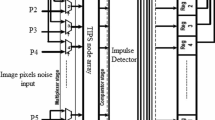Abstract
The conventional method for image impulse noise suppression is standard median filter utilization, which is satisfying for low noise densities, but not for medium to high noise densities. Adding a noise detection step, as proposed in the literature, makes this algorithm suitable for higher noises, but may degrade the performance at low noise densities. An adaptive switching median-based (ASM) algorithm has been used in this paper for noise suppression. First, the algorithm is modified to achieve a higher PSNR, especially for low noise densities. Then, the structure of the modified algorithm is improved to obtain higher operating speed in hardware implementation, for real-time applications. The implemented algorithm works in two steps, detection and filtering. The noise detection method is enhanced, by merging the amount of memory used for the algorithm implementation. As a result, less hardware resources are required, while the chance of false noise detection is reduced, due to the improvement made in the algorithm. In the filtering step, an adaptive window size is used, based on the measured noise density. This improved algorithm is adopted for more efficient hardware implementation. In addition, high parallelism is utilized to boost the operating frequency, and meanwhile, clock gating is used to lower power consumption. This architecture, then, has been implemented physically on an FPGA, and an operating frequency of 93 MHz is achieved. The hardware requirement is approximately 10,000 4-input LUTs, and the processing time for a 512 × 512 pixels image is measured at 12 ms.



















Similar content being viewed by others
References
CCD Image Sensor Noise Sources: Application Note, 1st edn. Eastman Kodak Company, Rochester (2001)
Cumani, C.: Introduction to CCDs. In: Neutron Radiography, Fifth International Topical Meeting on Garching (2004)
Varghese, Gijesh, Wang, Zhou: Video denoising based on a spatiotemporal Gaussian scale mixture model. IEEE Trans. Circuits Syst. Video Technol. 20, 1032–1040 (2010)
Jin, L., et al.: Quaternion-based impulse noise removal from color video sequences. IEEE Trans. Circuits Syst. Video Technol. 23, 741–755 (2013)
Gonzalez, R.C., Woods, R.E.: Digital Image Processing, 2nd edn. Prentice-Hall Inc, New Jersey (2002)
Guo, Q., et al.: An efficient SVD-based method for image denoising. IEEE Trans. Circuits Syst. Video Technol. 26, 868–880 (2016)
Yang, J., et al.: Image and video denoising using adaptive dual-tree discrete wavelet packets. IEEE Trans. Circuits Syst. Video Technol. 19, 642–655 (2009)
Malinski, Lukasz, Smolka, Bogdan: Fast averaging peer group filter for the impulsive noise removal in color images. J. Real-Time Image Proc. 11, 427–444 (2016)
Malinski, L., Bogdan S.: Fast adaptive switching technique of impulsive noise removal in color images. J. Real-Time Image Process. 1–22 (2016). doi:10.1007/s11554-016-0599-6
Chatterjee, P., Milanfar, P.: Is denoising dead? Image Process. IEEE Trans. 19(4), 895–911 (2010)
Ko, S.-J., Lee, Y.H.: Center weighted median filters and their applications to image enhancement. Circuits Syst. IEEE Trans. 38, 984–993 (1991)
Wang, Z., Zhang, D.: Progressive switching median filter for the removal of impulse noise from highly corrupted images. Circuits Syst II Analog Digit. Signal Process. IEEE Trans. 46, 78–80 (1999)
Windyga, P.S.: Fast impulsive noise removal. Image Process. IEEE Trans. 10, 173–179 (2001)
Chen, T., Ma, K.-K., Chen, L.-H.: Tri-state median filter for image denoising. Image Process. IEEE Trans. 8, 1834–1838 (1999)
Fabijanska, A., Sankowski, D.: Noise adaptive switching median-based filter for impulse noise removal from extremely corrupted images. Image Process. IET 5(5), 472–480 (2011)
Eng, H.L., Ma, K.K.: Noise adaptive soft-switching median filter. Image Process. IEEE Trans. 10(2), 242–251 (2001)
Andreadis, I., Louverdis, G.: Real-time adaptive image impulse noise suppression. Instrum. Meas. IEEE Trans. 53(3), 798–806 (2004)
Hwang, H., Haddad, R.: Adaptive median filters: new algorithms and results. Image Process. IEEE Trans. 4(4), 499–502 (1995)
Hu, Y., Ji, H.: Research on image median filtering algorithm and its FPGA implementation. In: Intelligent Systems. GCIS’09. WRI Global Congress on IEEE (2009)
Nieminen, A., Neuvo, Y.: Comments on theoretical analysis of the max/median filter” by GR Arce and MP McLaughlin. Acoust Speech Signal Process. IEEE Trans. 36, 826–827 (1988)
Baddar, S.W.A.H., Batcher, K.E.: Designing Sorting Networks: A New Paradigm. Springer, New York (2012)
Jayanthi Sree, S., Ashwin, S., Aravind Kumar, S.: Edge preserving algorithm for impulse noise removal using FPGA. In: Machine Vision and Image Processing (MVIP), 2012 International Conference on IEEE (2012)
Matsubara, T., Moshnyaga, V.G., Hashimoto, K.: A FPGA implementation of low-complexity noise removal. In: Electronics, Circuits, and Systems (ICECS), 17th IEEE International Conference on IEEE (2010)
Kamarujjaman, M.M., Maitra, M.: An efficient FPGA based de-noising architecture for removal of high density impulse noise in images. In: IEEE International Conference on Research in Computational Intelligence and Communication Networks (ICRCICN) (2015)
Mukherjee, M., Maitra, M.: Reconfigurable architecture of adaptive median filter—an FPGA based approach for impulse noise suppression. In: Computer, Communication, Control and Information Technology (C3IT), 2015 IEEE Third International Conference, pp. 1–6
Anand, M., Narasimha, Y.: Removal of salt and pepper noise from highly corrupted images using mean deviation statistical parameter. Int. J. Comput. Sci. Eng. 5(2), 113–119 (2013)
Fahmy, S.A., Cheung, P.Y., Luk, W.: Novel FPGA-based implementation of median and weighted median filters for image processing. In: Field Programmable Logic and Applications, International Conference, pp. 142–147 (2005)
Shi, P., Ward, R.K.: A neural network implementation of the median filter. In: Communications, Computers and Signal Processing, IEEE Pacific Rim Conference, pp. 513–516 (1989)
Gil, J., Werman, M.: Computing 2-D min, median, and max filters. In: Pattern Analysis and Machine Intelligence, IEEE Transactions, pp. 504–507 (1993)
Author information
Authors and Affiliations
Corresponding author
Rights and permissions
About this article
Cite this article
Taghinia Jelodari, P., Parsa Kordasiabi, M., Sheikhaei, S. et al. FPGA implementation of an adaptive window size image impulse noise suppression system. J Real-Time Image Proc 16, 2015–2026 (2019). https://doi.org/10.1007/s11554-017-0705-4
Received:
Accepted:
Published:
Issue Date:
DOI: https://doi.org/10.1007/s11554-017-0705-4




